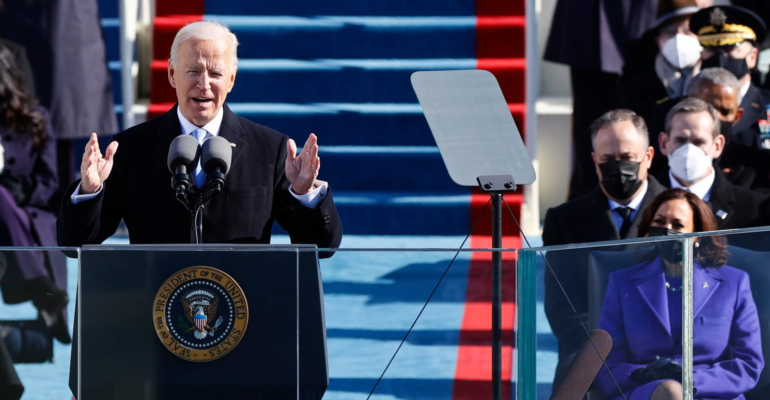Decoding the Biden inauguration speech – 5 Storytelling Lessons

Decoding the Biden inauguration speech – 5 Storytelling Lessons
After 4 chaotic years of shockingly divisive politics, the US is seeing a memorable transition in power.
No one knows what the next four years would bring. But this moment – a historic one – deserves its story to be told well.
And the responsibility of telling that story falls, disproportionately, on the shoulders of one guy.
Joseph Biden’s speechwriter.
(who, incidentally, happens to be of Indian origin).
In today’s post, I will share 5 storytelling techniques used in the US Presidential inauguration speech. (You can quickly read through the transcript, if you haven’t heard it).
A tough ask
Speeches given to a nation have a tough ask.
On the one hand, they need to connect with the collective emotional consciousness of the “nation” – a vast and incredibly diverse audience. The writing needs to acknowledge the audience’s pain, their silent sacrifices, their deep visceral fears. And let them know that they have been heard.
And on the other hand, it needs to point them towards a hopeful future. Reassure them, that all will be right. And perhaps even deliver some hard messages, that nudge them towards a desired future direction.
They also have to strike the right ‘tone’ – an amorphous quality in writing that is difficult to define but still needs to serve as a guiding light.
On that aspect, it was clear, given Biden’s personality and the nature of the occasion, that the tone and tenor of the speech would be conciliatory and not chest-thumping. About building bridges not burning them.
And while that is a noble sentiment, converting the same into words is not an easy task.
How did Biden (and Mr. Reddy) do?
Storytelling galore
While it is beyond my ability to analyse the speech’s contents, I have studied it for the storytelling techniques used – and those I found plenty!
Here are 5 that I found striking:
- Leading with Pathos
- Leveraging common ground
- Giving strong messages
- Use of contrast
- Use of anaphora
1. Leading with Pathos
Millenia back, the Greek rockstar, Aristotle had boiled down persuasion to three factors: Ethos (your credibility), Pathos (the emotional appeal) and Logos (logic).
This speech was overflowing with Pathos.
It comes across as a primal, emotional appeal – to forget what’s happened in the past, take strength from common values and jointly tackle some of the biggest challenges faced by the nation.
It employs short snappy sentences. Invokes tragedy, sacrifice and pride. And makes emotional promises, that seem to be written by a Hollywood dialogue-writer:
“I will always level with you.
I will defend the Constitution.
I will defend our democracy.
I will defend America.”
(It almost seemed like that emotional speech by the President in the movie ‘Independence Day’.)
It also remembers folks who lost their lives to Covid-19 and spares a moment of silence for them.
Essentially, Biden and Reddy decided to dial up the emotional lever to: “Statutory warning: Full-on Maximum level – Tears guaranteed”.
Ah well, the occasion demanded it.
Now, while the emotional element was more about how the content was written (and delivered), the next one was about what the content contained.
2. Leverage common ground
In 1984, Professor Robert Cialdini wrote a seminal book on the art of persuasion – called ‘Influence’. In the book, he boiled his ideas down to six techniques of influence: reciprocity, consistency, social proof, liking, authority, and scarcity.
In 2016, more than 30 years after the first book, Cialdini launched his second book – another bestseller called ‘Pre-Suasion’. It essentially built upon the same six principles, but from the point of view of influencing a person even before the transaction (hence ‘Pre’-suasion).
But Cialdini also added another, a seventh-principle for persuasion. He called this the ‘Unity principle’ – referring to the shared identity that the influencer shares with the audience.
Biden’s speech was all about this principle.
This concept can be tricky – what may be unifying for you (e.g. religion) may be a source of divisiveness for someone else.
So how did they apply this principle? They used themes that are at the bedrock of the nation:
- America, the nation and its people: All told Biden uses ‘America’, ‘American’ or the ‘nation’ 43 times in a speech with 2371 words. That’s almost once every 50 words or so. That’s frequent!
- The Constitution: which appears in 3 separate places
- Iconic American leaders, whose popularity cuts across the aisle – such as George Washington and Lincoln
- The National Anthem: from which he goes on to quote a relevant verse
(Interestingly, he also makes a reference to the Bible – but only once)
By using these “lowest common denominator” ideas that bind the entire nation, Biden was giving a clear message: what unites us is much more stronger than what divides us.
3. Giving strong messages
In contrast to the soothing balm of unifying themes, Biden’s speech does not miss tackling the bull by the horns – some of the urgent and deep issues that need to be solved by the country:
- Racial justice: “The dream of justice for all will be deferred no longer.”
- The climate crisis: “A cry of survival comes from the planet itself, a cry that can’t be any more desperate or any more clear”.
- Far-Right extremism: “… a rise of political extremism white supremacy and domestic terrorism that we must confront and we will defeat”.
I was a touch surprised by the use of the words ‘domestic terrorism’. Strong language.
4. Anaphora galore
I’ve written before about anaphora – the most-often used trope by a speechwriter. It’s super-powerful as a rousing tool.
As expected we find examples of anaphora galore in the speech:
- “With unity we can do great things, important things. We can right wrongs. We can put people to work in good jobs. We can teach our children in safe schools. We can overcome the deadly virus. We can reward work and rebuild the middle class and make healthcare secure for all. We can deliver racial justice and we can make America once again the leading force for good in the world”
- “Just look around. Here we stand in the shadow of the Capitol dome as was mentioned earlier, completed amid the Civil War, when union itself was literally hanging in the balance. Yet we endured. We prevailed. Here we stand looking out on the Great Mall where Dr. King spoke of his dream. Here we stand where 108 years ago, at another inaugural, thousands of protesters tried to block brave women marching for the right to vote.”
- “It will never happen. Not today. Not tomorrow. Not ever.”
You can use Anaphora at the speech’s beginning. You can use it in the middle. You can use it in the end. You can use it everywhere!
5. Contrast
Contrast is also a frequent technique used to make an idea more impactful by juxtaposing it with an opposing idea:
- “Today, we celebrate the triumph not of a candidate, but of a cause, the cause of democracy.”
- “I know the forces that divide us are deep and they are real. But I also know they are not new.”
- “I have just taken the sacred oath each of these patriots took — an oath first sworn by George Washington. But the American story depends not on any one of us, not on some of us, but on all of us”
Great moments in history deserve great storytelling. Joe Biden and Vinay Reddy seem to have left no stone unturned in crafting a speech that was reassuring and rousing in equal measure.
You may not have to write a Presidential speech in your life. But you can use some of these techniques to ensure greater impact for any high-stakes communication you may have to deliver. Best of luck!
PS: As a bonus, check out this rousing poem by the 22-year old poet, Amanda Gorman that everyone is raving about. Great to share with your (older) children.
Image Credit: voanews.com





